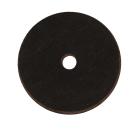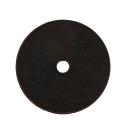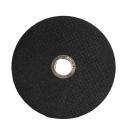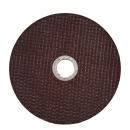Bodywork cut-off wheels

Bodywork cut-off wheels for cars and motorbikes
-
 91618Cut-off wheelsDiameter 75, thickness 1mm
91618Cut-off wheelsDiameter 75, thickness 1mm -
 91619Cut-off wheelsDiameter 75, thickness 1.6mm
91619Cut-off wheelsDiameter 75, thickness 1.6mm -
 GPS3518-1Cut-off wheelsDiameter 100, thickness 1mm
GPS3518-1Cut-off wheelsDiameter 100, thickness 1mm -
 GPS3518-1.5Cut-off wheelsDiameter 100, thickness 1.5mm
GPS3518-1.5Cut-off wheelsDiameter 100, thickness 1.5mm
︾
Advantages of bodywork tools for your car or motorbike repairs:
Abrasive discs, also known as cutting discs, are abrasive tools used to cut various materials such as metal, stone, plastic and other substances. Here are some of the benefits associated with using cut-off wheels:
Cutting accuracy :
Cut-off wheels offer a precise cut, allowing users to make clean, straight cuts in different materials. This precision is essential, especially in applications where precise measurements are required.
Versatility:
These discs are versatile and can be used to cut a variety of materials, such as metal, ceramic, stone, plastic, etc. This makes them suitable for a variety of applications in the construction, metallurgy and manufacturing sectors.
Cut-off wheel efficiency:
Cut-off wheels are designed for fast, efficient cutting. Their abrasive design enables rapid cutting action, reducing the time needed to complete cutting jobs.
Spark reduction:
Some cut-off wheels are specially designed to minimise spark generation during cutting. This makes them particularly suitable for environments where safety is a concern, such as in potentially flammable areas.
Different abrasive material options:
Abrasive discs are available with different types of abrasive grit, such as aluminium oxide, silicon carbide, diamond, etc. This allows you to choose the appropriate disc depending on the material to be cut.
Easy to use:
These discs are generally easy to install on angle grinders, cut-off saws and other power tools. This makes them accessible even to amateur users.
Durability:
Abrasive discs are often durable and can have a long service life, depending on the abrasive material used and the conditions of use.
Variety of sizes:
They are available in a range of sizes, allowing users to choose the right disc for their specific needs, whether for thin cuts or thicker cuts.
Reduced waste:
By producing clean, precise cuts, cut-off wheels help reduce waste associated with inaccurate or imperfect cuts.
Affordability:
Compared to other specialist cutting methods, cut-off wheels are often affordable tools, making them an economical choice for many applications.
Choosing the right type of cut-off wheel to suit the material to be cut and the specific requirements of the job is essential to maximise the benefits and ensure optimum performance.
Answers to questions about the use of cut-off wheels in the world of car bodywork:
Cut-off wheels are indispensable tools in the world of car bodywork, providing precise, clean cuts for a variety of applications. Here are some answers to questions frequently asked by users about the use of cut-off wheels in car bodywork:
1. What bodywork materials can I cut with a cut-off wheel?
Cut-off wheels are versatile and can cut different bodywork materials such as sheet metal, aluminium and even some plastics. Choose the disc according to the specific material you need to cut.
2. How can I ensure a precise cut on delicate bodywork?
For accurate cuts on delicate areas, choose a cut-off wheel of the right diameter and make sure you have a steady hand and precise control of the tool. You can also use cutting guides for greater precision.
3. Do cut-off wheels generate a lot of sparks when cutting bodywork?
This depends on the type of cut-off wheel used. Some discs are designed to reduce sparks, which is particularly useful in fire-sensitive environments.
4. Can I use the same cut-off wheel for different types of metal on a car?
It is recommended that you use a disc that is suitable for the specific type of metal you are cutting. Some metals may require discs with different abrasive compositions for optimum cutting.
5. How can I prolong the life of a cut-off wheel used in car bodywork?
Avoid excessively fast cuts, keep the tool at an appropriate speed, and make sure you choose the right disc for the specific material you are cutting. Lubrication can also be used to reduce heat and wear.
6. What is the difference between a standard cut-off wheel and a non-sparking wheel?
Anti-spark discs are designed to minimise spark generation, making them suitable for applications where safety is a concern. However, performance may vary depending on the material being cut.
7. Can a cut-off wheel be used to remove rust from bodywork?
Although cut-off wheels are primarily intended for cutting, some models can be used to remove rust lightly. However, specific surface preparation tools may be more appropriate.
8. What is the best way to cut thicker sections of bodywork?
Use an appropriately sized cut-off wheel with a suitable cutting thickness. Wider discs can be useful for thicker cuts, but make sure you follow the tool specifications.
9. Can I cut complex shapes in the bodywork with a cut-off wheel?
Yes, but this requires a certain amount of skill. For complex cuts, consider using reciprocating saws or cutting tools specific to the shape you want to achieve.
10. What is the main difference between cut-off wheels for metals and those for car bodywork?
In general, cut-off wheels for car bodywork are adapted to the metals used in car manufacture and can have specific characteristics for precise cutting on these materials.
By understanding how to choose and use car body cut-off wheels correctly, professionals can make precise and efficient cuts, contributing to high quality car body repair work.